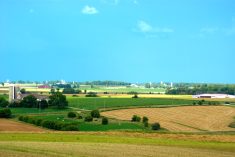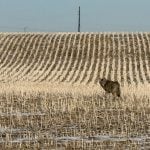The capabilities of digital technologies change regularly, but how developers speak about adoption in the ag-sector doesn’t. The rhetoric and questions posed are the same as those asked several years ago — namely, what is required for more farms to adopt data technologies?
The fact that such a fundamental question has not changed makes me wonder, who working in this field is still oblivious to the practical challenges of adopting new tech on the farm?
And at a high level, are solutions to key overarching issues, like the need for universal data systems, even feasible?
Read Also

Women who fed a nation
More than 40,000 young women supported the war effort between the 1940s and early 1950s, helping grow and harvest crops amid labour shortages. They were called Farmerettes.
If they’re not, I’d like to know.
Farm-level challenges
In 2018, I spoke at a Texas A&M University conference where ag-data technology developers, marketers, and researchers deliberated on why so much of the world’s farm community has yet to integrate digital tools into day-to-day operations. General conclusions included a lack of verifiable return on investment and prohibitive user costs, privacy issues, operational complexity and other factors as major farm-level barriers.
These same reasons were reflected by panellists speaking during an Alltech virtual conference in July, 2020. Quite the longevity to be sure.
My own experience covering this subject suggests many companies remain oblivious to farmer needs, or are generally uninterested in changing an already-working (though exclusionary) business model.
If, for example, a piece of hardware (a drone) costs several thousand dollars, the fee for unlocking and accessing the software should not also be several thousand dollars.
Few other than the most enthusiastic growers, or those in greatest need, would willingly accept that kind of budgetary double tap.
A lot of cutting-edge hardware and software also tends to arrive via new iron. But the latest and greatest combine is expensive and not affordable for every grower, thus the tech within remains inaccessible to many, at least for the time being.
Conversely, I’ve stumbled across many examples of tech developers trying to address these issues — driving down analysis costs, simplifying platform mechanics, producing more effective and cheaper aftermarket solutions, and so on.
Whether individual approaches actually work I don’t know (my first-hand experience with data tools is extremely limited), but the idea is there. This gives me hope that, by the time I’m ready to bring a new tool to our farm, there will be a wider range of verifiably workable solutions to choose from.
To the credit of developers and salespeople, an understanding that not every solution will work for every farm is something else I’ve more frequently encountered.
Calling everything a game-changing “disruptor,” after all, takes the teeth out of the term. Getting away from Silicon Valley “start-up- speak” makes claims more believable, and likely helps adoption overall.
High-level and proprietary challenges
Data interoperability and the siloing of data systems, however, is a real elephant in the room.
Experts across a wide range of industries have been evangelizing the need for data interoperability for some time. What people need, they say, is the ability to generate information with one thing, apply it seamlessly elsewhere, and actually make it do something useful. This can be done if tech developers take what’s been called an “ecosystems” approach.
But to the layperson what that means is still a bit of an abstract concept. On top of that, is seems to fly in the face of proprietary business models, and I don’t think large equipment manufacturers are giving that up anytime soon.
How does one develop an ecosystem? Does Microsoft, IBM, Apple, Google the all-powerful, and the United States military all need to agree on a standard data system, then incorporate that system against proprietary prerogatives? I’ve heard of such initiatives, but is it on a large enough scale to actually create the environment being advocated?
Is such a thing even possible? If not, should we even focus on the question in light of other ongoing concerns — the perpetually absurd saga of poor rural internet connectivity being just one example?
Perhaps the answer is much simpler than this. Indeed, these queries might be laughable to professionals in-the-know, but I, and likely most of us, are not in-the-know. We hear abstract answers for abstract problems, then head back to the field and barn to worry about more earthly matters.
To data experts, I ask you to describe exactly how free-flowing data will change how we live and work on the farm. Use clear examples. What will it look like? What are the associated costs, savings, privacy safeguards, and so on?
But first, show us how we could get there — and the roles we might play.















